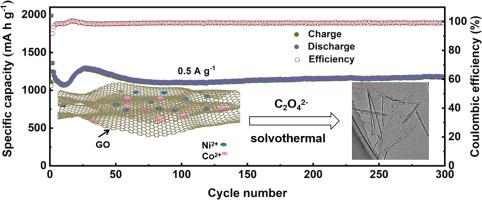Journal of Colloid and Interface Science ( IF 9.9 ) Pub Date : 2021-09-14 , DOI: 10.1016/j.jcis.2021.09.066 Yingying Zhang 1 , Yutao Dong 2 , Ruipeng Wei 1 , Hui Guan 1 , Xiyang Kang 1 , Mohammed A Al-Tahan 3 , Jianmin Zhang 1

|
Transition metal oxalates have attracted wide attention due to the characteristics of the conversion reaction as anode materials in lithium-ion batteries (LIBs) and sodium-ion batteries (SIBs), However, there are huge volume expansion and sluggish circulation dynamics during the reversible Li+ and Na+ insertion/extraction process, which would lead to unsatisfactory reversible capacity and stability. In order to solve these problems, a rod-like structure Ni0.5Co0.5C2O4·2H2O is in-situ formed on the reduced graphene oxide layer (Ni0.5Co0.5C2O4·2H2O/rGO) in a glycol–water mixture medium via an interface induced engineering strategy. Benefitting from the synergistic cooperation of nano-diameter rod-like structure and high conductive rGO networks, the experimental results show that the prepared Ni0.5Co0.5C2O4·2H2O/rGO electrode has predominant rate performance and ultra-long cycle stability. For the LIBs, it not only exhibits an ultrahigh reversible capacity (1179.9 mA h g−1 at 0.5 A g−1 after 300 cycles), but also presents outstanding rate and cycling performance (646.5 mA h g−1 at 5 A g−1 after 1200 cycles). Besides, the Ni0.5Co0.5C2O4·2H2O/rGO electrode displays remarkable sodium storage capacity of 221.6 mA h g−1 after 100 cycles at 0.5 A g−1. Further, the extraordinary electrochemical capability of Ni0.5Co0.5C2O4·2H2O/rGO active material is also reflected in two full-cells, assembled using commercial LiCoO2 as cathode for LIBs and commercial Na3V2(PO4)3 as cathode for SIBs, both of which can show wonderful specific capacity and cycling stability. It is found in in-situ Raman experiments that the reversible changes of oxalate peaks are monitored in a charge/discharge process, which is scientific evidence for the transform reaction mechanism of metal oxalates in LIBs. These findings not only provide important ideas for studying the charge/discharge storage mechanism but also give scientific basis for the design of high-performance electrode materials.
中文翻译:

通过界面诱导工程在 rGO 上原位形成棒状 Ni0.5Co0.5C2O4·2H2O:作为锂离子和钠离子半/全电池阳极的非凡倍率和循环性能
过渡金属草酸盐由于作为锂离子电池(LIBs)和钠离子电池(SIBs)负极材料的转化反应特性而受到广泛关注,但在可逆锂离子电池过程中存在巨大的体积膨胀和缓慢的循环动力学。+和 Na +插入/提取过程,这将导致不令人满意的可逆容量和稳定性。为了解决这些问题,在还原氧化石墨烯层(Ni 0.5 Co 0.5 C 2 O 4 )上原位形成棒状结构Ni 0.5 Co 0.5 C 2 O 4 ·2H 2 O·2H 2 O/rGO) 在乙二醇-水混合介质中通过界面诱导工程策略。得益于纳米直径棒状结构和高导电rGO网络的协同作用,实验结果表明所制备的Ni 0.5 Co 0.5 C 2 O 4 ·2H 2 O/rGO电极具有优异的倍率性能和超长循环稳定。对于LIBS,它不仅显示出超高的可逆容量(1179.9毫安ħ克-1在0.5 A克-1 300次循环后),但也呈现优秀率和循环性能(646.5毫安ħ克-1在5 A G -11200 次循环后)。此外,Ni 0.5 Co 0.5 C 2 O 4 ·2H 2 O/rGO 电极在0.5 A g -1 下循环100 次后显示出221.6 mAh g -1 的显着储钠容量。此外,Ni 0.5 Co 0.5 C 2 O 4 ·2H 2 O/rGO 活性材料的非凡电化学性能也反映在两个全电池中,使用商用 LiCoO 2作为锂离子电池的阴极和商用 Na 3 V 2 (PO 4 ) 3作为SIBs的正极,两者都表现出极好的比容量和循环稳定性。原位拉曼实验发现,在充电/放电过程中监测到草酸盐峰的可逆变化,这是LIBs中金属草酸盐转化反应机理的科学依据。这些发现不仅为研究充放电存储机制提供了重要思路,而且为高性能电极材料的设计提供了科学依据。



























 京公网安备 11010802027423号
京公网安备 11010802027423号